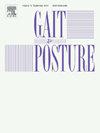步态改造使用鞋垫与突出增强足底感觉反馈减少最大外膝关节内收力矩膝骨关节炎患者
IF 2.2
3区 医学
Q3 NEUROSCIENCES
引用次数: 0
摘要
背景:膝关节内侧骨关节炎(OA)的进展与膝关节内侧腔室机械应力增加有关。膝关节内收力矩(KAM)是这种应力的关键指标。在步态过程中,可以通过调整压力中心(COP)轨迹来减少KAM。短期训练使用塑料半球突起贴纸,以增强足底感觉反馈,使自愿控制COP轨迹的健康个体。然而,这种干预对膝关节OA患者的有效性尚不清楚。研究问题本研究旨在验证采用增强足底感觉反馈的鞋垫进行步态改良训练是否可以降低膝关节OA患者步态中的KAM和膝关节内收角。方法对22例膝关节骨性关节炎患者在控制和鞋垫条件下进行三维步态分析。在对照条件下,测量时无任何突出。在鞋垫条件下,半球形突起附着于足跟和第一跖骨头。参与者接受训练,通过加载到突出物上来控制COP轨迹。然后,在没有突出的情况下进行测量。结果与对照组相比,鞋垫条件显著降低了膝关节最大KAM (p <; 0.001)、最大KAM处膝关节内收角(p = 0.002)和膝关节内收角脉冲(KAAI) (p = 0.013)。在最大KAM处,步长和地面反作用力大小无统计学差异。意义该干预可有效降低膝关节OA患者的KAM和膝关节内收角。本文章由计算机程序翻译,如有差异,请以英文原文为准。
Gait modification using an insole with protrusions enhancing plantar sensory feedback reduces maximum external knee joint adduction moment in patients with knee osteoarthritis
Background
Medial knee osteoarthritis (OA) progression is linked to increased mechanical stress in the medial knee compartment. The knee adduction moment (KAM) is a key indicator of this stress. The KAM can be reduced by adjusting the center of pressure (COP) trajectory during gait. Short-term training using plastic hemispherical protrusion stickers to enhance plantar sensory feedback enables voluntary control of the COP trajectory of healthy individuals. However, the effectiveness of this intervention for patients with knee OA is unclear.
Research question
This study aimed to verify whether gait modification training using an insole with enhanced plantar sensory feedback through protrusions can decrease the KAM and knee adduction angle during gait of patients with knee OA.
Methods
Twenty-two patients with knee OA underwent a three-dimensional (3D) gait analysis under control and insole conditions. Under the control condition, measurements were performed without any protrusions. Under the insole condition, hemispherical protrusions were attached to the heel and first metatarsal head. Participants received training to control their COP trajectory by loading onto the protrusions. Then, measurements were performed without protrusions.
Results
The insole condition significantly reduced the maximum KAM (p < 0.001), knee adduction angle at the maximum KAM (p = 0.002), and knee adduction angular impulse (KAAI) (p = 0.013) compared with those under the control condition. No statistically significant differences were observed in step length and ground reaction force magnitude at the maximum KAM.
Significance
This intervention can effectively reduce the KAM and knee adduction angle of patients with knee OA.
求助全文
通过发布文献求助,成功后即可免费获取论文全文。
去求助
来源期刊

Gait & posture
医学-神经科学
CiteScore
4.70
自引率
12.50%
发文量
616
审稿时长
6 months
期刊介绍:
Gait & Posture is a vehicle for the publication of up-to-date basic and clinical research on all aspects of locomotion and balance.
The topics covered include: Techniques for the measurement of gait and posture, and the standardization of results presentation; Studies of normal and pathological gait; Treatment of gait and postural abnormalities; Biomechanical and theoretical approaches to gait and posture; Mathematical models of joint and muscle mechanics; Neurological and musculoskeletal function in gait and posture; The evolution of upright posture and bipedal locomotion; Adaptations of carrying loads, walking on uneven surfaces, climbing stairs etc; spinal biomechanics only if they are directly related to gait and/or posture and are of general interest to our readers; The effect of aging and development on gait and posture; Psychological and cultural aspects of gait; Patient education.
 求助内容:
求助内容: 应助结果提醒方式:
应助结果提醒方式:


